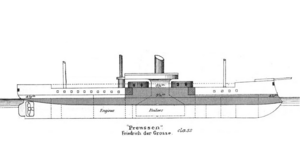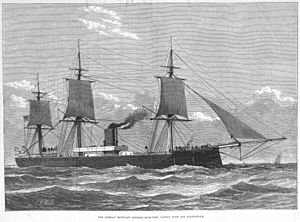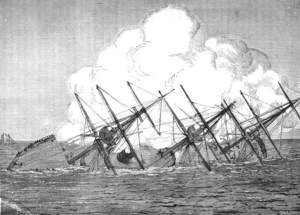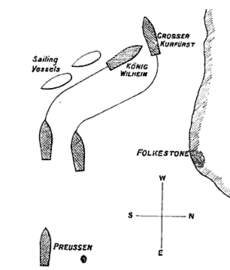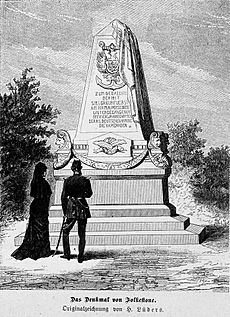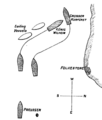SMS Grosser Kurfürst (1875) facts for kids
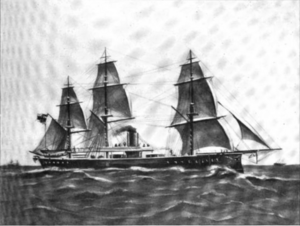
SMS Grosser Kurfürst underway on her maiden voyage
|
|
Quick facts for kids History |
|
|---|---|
| Name | SMS Grosser Kurfürst |
| Builder | Kaiserliche Werft Wilhelmshaven |
| Laid down | 1869 |
| Launched | 17 September 1875 |
| Commissioned | 6 May 1878 |
| Fate | Accidentally rammed and sunk by SMS König Wilhelm 31 May 1878 |
| General characteristics | |
| Class and type | Preussen-class ironclad |
| Displacement | |
| Length | 96.59 m (316 ft 11 in) |
| Beam | 16.30 m (53 ft 6 in) |
| Draft | 7.11 m (23 ft 4 in) |
| Installed power | |
| Propulsion |
|
| Sail plan | Full-rigged ship |
| Speed | 14 knots (26 km/h; 16 mph) |
| Range | 1,690 nmi (3,130 km) at 10 kn (19 km/h) |
| Complement |
|
| Armament |
|
| Armor |
|
SMS Grosser Kurfürst was a large armored warship built for the German Imperial Navy. She was started in 1870 and finished in 1878. Her construction took a long time because her design was changed after building began. Originally, her main guns were to be in a central armored area. But later, they were moved to two large gun turrets in the middle of the ship.
Sadly, Grosser Kurfürst sank on her very first trip. This happened when another German warship, SMS König Wilhelm, accidentally crashed into her. The two ships, along with SMS Preussen, were sailing in the English Channel on May 31, 1878. They saw some fishing boats and tried to avoid them. But Grosser Kurfürst turned into the path of König Wilhelm and was hit. She sank in about 15 minutes. Between 269 and 284 of her crew members drowned. This accident led to many investigations.
Contents
Ship Design and Features
The Preussen-class ships were approved in 1867. This was part of a plan to make the German navy stronger. The plan came after the Second Schleswig War, when the weak Prussian Navy could not stop the Danish Navy from blocking their ports. These ships were first planned as "casemate ships." This meant their guns would be in a protected central area. But they were later redesigned as "turret ships," with guns in rotating towers. They were the first group of armored warships built for the German fleet.
Ship Dimensions and Power
Grosser Kurfürst was about 96.59 meters (316 feet) long. She was 16.30 meters (53 feet) wide. Her draft, or how deep she sat in the water, was about 7.12 meters (23 feet).
The ship was powered by one steam engine. This engine turned a single propeller. Six coal-fired boilers created the steam, and the smoke went out through one tall funnel. The ship could reach a top speed of 14 knots (about 26 kilometers per hour). She also had a full set of sails, like a large sailing ship. A normal crew for the ship was 46 officers and 454 sailors.
Guns and Armor
Grosser Kurfürst had four large 26-centimeter (10-inch) guns. These guns were placed in two turrets in the middle of the ship. She also had two smaller 17-centimeter (6.7-inch) guns. One was at the front of the ship and one at the back.
The ship's armor was made of strong iron with thick wood behind it. The main armor belt around the ship's side was in two layers. The top layer was 203 millimeters (8 inches) thick. The bottom layer was between 102 and 229 millimeters (4 to 9 inches) thick. Both layers had 234 to 260 millimeters (9 to 10 inches) of wood backing. The gun turrets had armor between 203 and 254 millimeters (8 to 10 inches) thick.
Ship's History
The Imperial Navy ordered Grosser Kurfürst from the Imperial Dockyard in Wilhelmshaven. It's not clear exactly when her construction began. Some historians say work started in 1869. Others say the shipyard itself wasn't finished until December 1869. It's also not known if any work started before the Franco-Prussian War in July 1870. The ship's name was slightly changed during construction.
The ship was launched on September 17, 1875. A high-ranking official, General Albrecht von Stosch, named the ship. Work on the ship was mostly done by December 1877. This allowed her to begin sea trials, which are tests at sea. She was officially put into service on May 6, 1878. Even then, shipyard workers were still on board. Captain Alexander von Monts was put in command. The ship took a long time to build because of delays from the Franco-Prussian War. Also, the new shipyard was still learning, and the ship's design was changed after building began.
The Collision and Sinking
In April 1878, a group of armored warships was made ready for summer training. Grosser Kurfürst was ordered to join this group. It included her sister ship Preussen, the large warship SMS König Wilhelm, and a smaller ship called Falke. Grosser Kurfürst joined on May 27, just three weeks after her crew came aboard. This was not enough time for the crew to get to know the ship well. The commander, Carl Ferdinand Batsch, knew the crew wasn't ready. But he followed orders and told Grosser Kurfürst to join anyway. Another ship, Friedrich der Grosse, was damaged and couldn't join.
The three ships left Wilhelmshaven on May 29, heading for the Mediterranean Sea. Soon after leaving Germany, Falke had engine problems and left the group. While crossing the North Sea, Grosser Kurfürst's rudder got stuck for a short time, but the crew fixed it. The ship also had trouble staying in line with the other warships. This was partly due to poor coal and inexperienced crew in the boiler room.
On May 31, the German ships entered the English Channel. They were sailing in two lines. König Wilhelm led the left line, followed by Preussen. Grosser Kurfürst was alone to their right. At 7:40 AM, they passed a lightship. Fifty minutes later, they entered the Strait of Dover.
Five minutes after entering the strait, Commander Batsch ordered Grosser Kurfürst to move closer to the other ships. Captain Monts took control of the ship's steering wheel himself. At 9:00 AM, the ships passed the narrowest part of the strait, moving at 9 knots (about 17 kilometers per hour). Soon after, near Folkestone, they saw a large sailing ship and a smaller one. These ships were about 600 meters (2,000 feet) away.
To avoid hitting the merchant ships, König Wilhelm and Preussen turned right. Grosser Kurfürst also turned, but she and König Wilhelm accidentally turned towards each other. Captain Monts ordered his ship's engines to full power and turned hard right to avoid the flagship. Commander Batsch ordered König Wilhelm to turn hard left. But neither ship could turn fast enough.
König Wilhelm was pointing right at Grosser Kurfürst. Her ram bow, a sharp point at the front of the ship, tore a huge hole in Grosser Kurfürst's side. The crash was so bad that Grosser Kurfürst was pushed sideways. Part of her mast was torn off, and many of her lifeboats on one side were destroyed.
König Wilhelm pulled away from Grosser Kurfürst and slowly went back to her original path. Water quickly flooded into König Wilhelm, but her crew managed to control it. However, the crew on Grosser Kurfürst could not stop the flooding. The hole was in a bad spot, right where a wall designed to keep water out was located. Also, other waterproof walls on Grosser Kurfürst were not properly sealed. This caused her to sink very quickly. As the ship took on more water, she leaned more and more. Water started pouring in through open windows.
Captain Monts tried to steer the damaged ship into shallower water. But she was too far gone. About 15 minutes after the crash, Grosser Kurfürst turned over and sank. Just before she went down, Monts ordered the crew to leave the ship.
Rescue Efforts and Lives Lost
König Wilhelm slowly came back and lowered all her boats to pick up the men in the water. Preussen stopped about 800 meters (half a mile) away. Her captain decided to strictly follow rules. Nearby British fishing boats and other ships also helped with the rescue. They picked up about 60 men. Captain Monts was rescued by one of König Wilhelm's boats, but it flipped over because too many people were on it. He then helped another man stay afloat until they were picked up by another boat.
The number of people who died varies in reports. Some say 269 died out of 500 crew members. Others say 276 or 284 died out of 487 on board. Many of the bodies were buried in Cheriton Road Cemetery in Folkestone. A famous composer, Arthur Sullivan, saw the accident. He wrote, "I saw it all – saw the unfortunate vessel slowly go over and disappear under the water in clear, bright sunshine, and the water like a calm lake. It was too horrible – and then we saw all the boats moving about picking up the survivors."
König Wilhelm was badly damaged with a lot of water in her front section. Her captain first wanted to run the ship aground to stop it from sinking. But he realized the ship's pumps could handle the water. The ship went to Portsmouth for temporary repairs. The survivors were taken back to Germany on the two warships and Falke, which had fixed her engines and arrived by then. After the crash, the German navy held a special court hearing. This was to investigate the sinking and find out what happened.
The Inquiry and Its Results
During the investigation, Captain Monts said he didn't have enough time to get used to the ship or its crew. He felt the new ship should have had four to six weeks of preparation, not just three. The day before the ships left, Commander Batsch told his superior that many shipyard workers were still finishing work on Grosser Kurfürst.
The investigation board decided that Commander Batsch was at fault and that Captain Monts was not. Their report came out on July 22. The head of the Imperial Admiralty, General Stosch, tried to influence the investigation. He wanted to blame Monts to protect Batsch, who was his favorite officer. Stosch's attempts to change the outcome made the Kaiser (Emperor) Wilhelm I scold him for his behavior.
Stosch was very angry that the investigation allowed criticism of his decisions. He blamed Reinhold von Werner, who led the inquiry. Stosch asked the Kaiser for a new court hearing for the officers involved. He also tried to force Werner out of the navy. Stosch wanted Batsch to be the next leader after he retired. Even though Werner was popular, he couldn't stop Stosch. He asked to retire on October 15, 1878.
The second court hearing again found Batsch guilty and Monts innocent. A third investigation in January 1879 changed this. It found Monts and the officer in charge of the watch on König Wilhelm guilty. Monts was sentenced to a short prison term, but the Kaiser refused to make him serve it. This led to another trial in June, which went back to the first decision and sentenced Batsch to six months in prison. The Kaiser reduced Batsch's sentence after two months. Stosch was upset that his favorite officer was blamed. He asked for another court hearing for Monts, who was again found not guilty. The Kaiser approved this decision, which finally ended the long series of trials. Batsch offered to resign, but the Kaiser refused. Instead, Batsch was promoted in 1880.
What Happened After the Sinking
The accident showed naval leaders that new crews needed much more time to learn about a ship before it was ready for service. The way commands were given to the steering crew was also changed. General Stosch's power in the navy and in politics became weaker. Many navy officers blamed him for rushing the ship into service. They said that "one cannot make a ship ready for service in a few days like a regiment." Stosch had been an ally of a liberal political party. But his relationship with them was damaged when reports about the accident, which he promised to share with parliament, were labeled military secrets.
Another result of the sinking was that the German parliament became unwilling to spend money on the navy for many years. For example, they refused to approve money for new large warships for most of the 1880s. Also, the design for a new armored ship, Oldenburg, had to be made much smaller because there wasn't enough money.
The lives lost in the sinking of Grosser Kurfürst are remembered by a large stone monument. It was put up in Cheriton Road Cemetery in Folkestone on January 12, 1881. A German training ship brought it from Germany. Another monument was placed in front of a naval infantry barracks to remember the marines who died.
Divers looked at the wreck right after the sinking. They found the hull upside down but in good condition, except for the large hole from König Wilhelm's ram. British officials thought it would be impossible to raise the ship. But the Germans still sent a team to try. They were not successful. A private company offered to raise the wreck to get its guns and other equipment, but this also didn't work out. Engineers tried using compressed carbon dioxide, but their tests failed. The Germans thought about more projects to salvage the wreck as late as 1903.
In 2020, it was announced that the memorial would be protected as a historic building. The wreck itself would also be protected. This allows people to dive to the wreck with a license but stops anyone from taking things from it.
Images for kids


